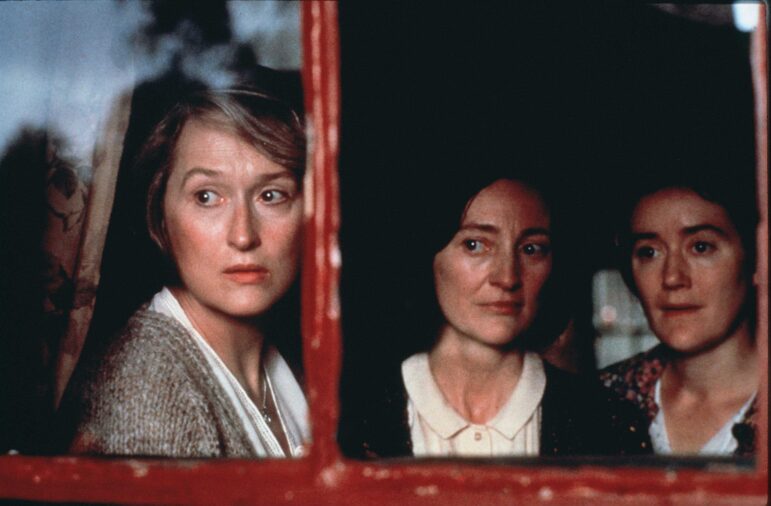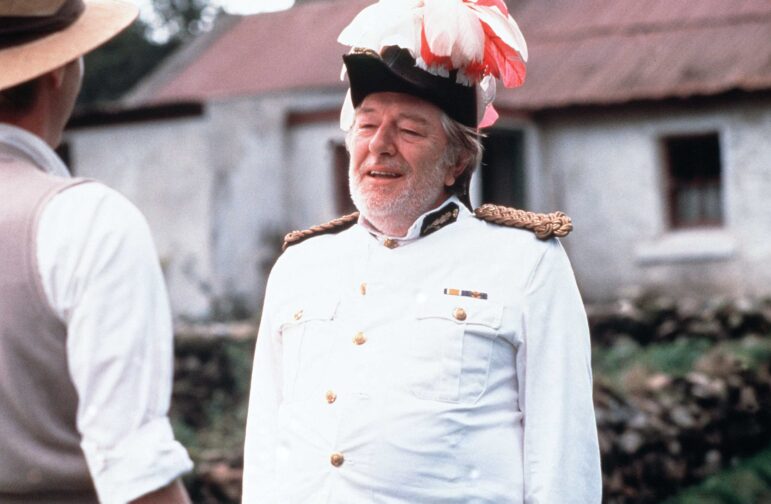
“A miracle!”
“It’s not a miracle, Jack. It’s science.”
“It’s not science. It’s the god of Lughnasadh!”
“Pagan nonsense, celebrating the feast of Lughnasadh. This is the month of August. The feast of our lady’s assumption into heaven.”
“A goddess rising through the sky and the stars in search for her dear son.”
This early exchange is from Pat O’Connor’s 1998 Irish-British-American period drama film, “Dancing at Lughnasa.” Adapted from the 1990 Brian Friel play of the same name, it tells the story of five destitute sisters living in Ballybeg, Donegal, in the 1930s. Ireland between the wars is impoverished and depressed in every sense of the word, and pleasures are few.
The inciting argument about Lughnasadh takes place between Kate Mundy (Meryl Streep), the eldest sister, and brother Jack (Michael Gambon), a Catholic priest recently returned from his mission to serve lepers in Uganda. The one who invokes the god of Lughnasadh is youngest sister Rose (Sophie Thompson), a developmentally disabled young woman, and the one who keeps the door of the bleak house open to fun, mystery, and the forbidden joys of paganism.

Meryl Streep, Brid Brennan, and Sophie Thompson in “Dancing at Lughnasa” (1998) [Sony Pictures Classics]
These pagan customs of joy and abandon are the subject of the film, despite the main character being a bastard child doomed to ignominy and shame because of his country’s institutionalized faith and custom. Michael (Darrell Johnston) is a child in a house of women when his uncle returns from Africa. Having been conceived in an affair between his mother Christina (Catherine McCormack) and a secretly married man who sees his by-blow only seldom, Michael narrates the events of the movie from his perspective as an adult while the audience sees him at the age of about 10, subject to the shame the adults cast on his existence while being only partially capable of understanding it.
Less understood still is the film’s central holiday. Witches and Pagans alike will recognize the Celtic holiday of Lughnasadh. The more syncretized among us may call it by its Catholic assimilationist feast name: Lammas. The holiday that has just recently gone by us on the Wheel of the Year is the first harvest. In Irish folklore, the first of August is the day on which Lugh, a god of skill and mastery and law, concluded an event somewhat like the Olympic games called the Assembly of Talti. (The story is told in the Cath Maige Tuired, otherwise known as the “Battle of Moytura” and the Aided Chlainne Lir, or “Children of Lir.”)
In records of ancient Christianity, Lammas is the feast of first fruits, a time when a lamb might be sacrificed to the Christian god, or else fruits and ripe wheat. This feast marks a place where the agricultural year and the liturgical year come together, an important facet of the early church, which was made of parishioners who were living with the cycles of the earth in a way that few humans do now. (For further information on this, see Ronald Hutton’s Stations of the Sun: A History of the Ritual Year in Britain and Ann Lewin’s Seasons of Grace: Inspirational Resources for the Christian Year.)
The holiday that results from this long relationship between Celtic/Gaelic/Brythonic indigenous ethnic groups’ myths and the early Catholic church in the British Isles is less than cohesive, and the Pagan adoption of it is yet another layer of complexity. Suffice it to say: the Mundy family is celebrating a Lughnasadh that is both like and unlike the one your coven held earlier this month.
Instead, the Mundy family is contending with shame. They’re ashamed that Michael is an illegitimate son. They’re ashamed that Jack has returned from Uganda because of nerves or an inability to serve any longer. They’re ashamed that they’re all unmarried, even Rose, who they refer to as “simple” in a dearth of understanding for her disability, and whom they must especially shield from the predations of unscrupulous men. Most of all, they’re ashamed of their own pagan customs.
There isn’t much to these customs, mind. We do not see the Mundy family engaged in ritual of any kind. Kate chastises her younger sisters for what she sees as their pagan behaviors. The family uses the term “pagan” in the Catholic sense: a lower-case catch-all for not only the pre-Christian beliefs of their Irish forbears and the indigenous tribal religions that have shaped brother Jack’s understandings of the world, but also anything fleshly, pleasurable, or morally flexible. To Kate, the “righteous bitch” as she calls herself, that includes singing, dancing, and the out-of-wedlock birth of her nephew.
Christianity was introduced in Uganda in the 1870s, arriving a mere twenty or thirty years after Islam had begun to make inroads among the tribes there. Jack Mundy was therefore ministering to a population only three or four generations deep into monotheism, in a nation where, according to the Catholic church itself, the practice of global religions was still deeply inflected by the culture that pre-existed missionaries of all kinds by centuries. It is in this dubious parallelism that “Dancing at Lughnasadh” is really striving to exist. Reaching for meaning in the way that beliefs change over time, and in the difference between how a nation Christianized in the fourth century of the common era has sublimated and surrendered its indigenous religion versus a nation broadly Christianized in the late 19th.

Michael Gambon in “Dancing at Lughnasa” (1998) [Sony Pictures Classics]
“In Africa, when we want to please the spirits, we kill a rooster or a small goat,” says Father Jack. His memory is not what it was when he left for Uganda, and he returns unable to separate the rituals of the Catholic mass, which he was sent to administer, from the rituals he learned there, from the people of Uganda. The religions of the various tribes of Uganda are anthropologically described as animist, with variation between different groups in cosmology, traditions, and custom. Sacrifice of animals and fruits is indeed among these customs, as it was in the pre-Chrisitian religions of the British Isles, as well as in early Christianity. When the Mundy sisters decide they want to please the spirits, they decide they will attend the town dance at Lughnasadh. They exclaim that they will go and dance “like we used to!” as Agnes (Bríd Brennan) puts it.
Does she mean herself and her sisters when they were younger? Or does she mean the way her own tribal antecedents used to do? When Father Jack describes the rituals “we” do to honor the great goddess of the earth, does he mean Obe, whom he learned to worship and propitiate in Uganda, or does he mean his goddess Mary, whose assumption he learned to celebrate in seminary?
By the time the film reaches its climax, at the Lughnasadh dance in the Donegal back hills, it’s clear to see the difference between the film’s depiction of Catholic misery juxtaposed against pagan (and Pagan) joy. The dancing and debauchery around the Lughnasadh fire reaches a fever pitch that the Mundy sisters recognize as danger, since their Christian modesty is their charm against worse misery than the one in which they live.
Nevertheless, they cannot escape their own desire for that excitement. Safely, in their own home and garden, the Catholic Mundy sisters still do their Pagan dance.
“Dancing at Lughnasa” can be streamed on Amazon Prime and Tubi.
The Wild Hunt is not responsible for links to external content.
To join a conversation on this post:
Visit our The Wild Hunt subreddit! Point your favorite browser to https://www.reddit.com/r/The_Wild_Hunt_News/, then click “JOIN”. Make sure to click the bell, too, to be notified of new articles posted to our subreddit.